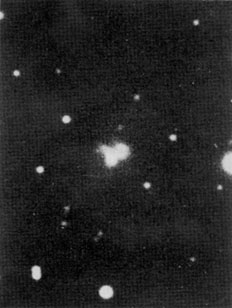

© CAMBRIDGE UNIVERSITY PRESS 1983, 1993
| |
1.4 Radio Sources
The advent of radio astronomy led to the discovery of strong sources of radio emission outside the Galaxy. As we shall see in Chapter 10, these radio sources also serve as useful probes of the structure of the universe. The first extragalactic radio source, Cygnus A, was discovered by J.S. Hey, S.J. Parsons, and J.W. Phillips in 1946. When the position of the radio source in the sky could be accurately specified, W. Baade and R.M. Minkowski, at the Mt. Wilson and Palomar Observatories, located what looked like a pair of colliding galaxies at the position of the radio source (see Figure 1.14). This process of identifying an object on the photographic plate at (or very close to) the position of the radio source is known as optical identification of the radio source. The discovery of Cygnus A led to the early view that radio sources arise from collisions of galaxies.
Eventually, however, it turned out that Baade was wrong in considering the optical object at Cygnus A a pair of colliding galaxies. In the seventies it became possible to study structures of radio sources in great detail. (Very-long-baseline interferometry can detect structures at the angular scale of less than a milliarc second.) The picture that has emerged not only for Cygnus A but for a majority of extragalactic radio sources is shown in Figure 1.15.

|
Fig. 1.14. The radio source Cygnus A is located around the optical object at the centre of the photograph. (Courtesy of Palomar Observatory, California Institute of Technology.) |
Here we have two radio-emitting blobs on opposite sides of a central
component, usually located close to, and on opposite sides of, a galaxy
or a quasar. It is believed that radio emission takes place in the blobs
from the acceleration of fast-moving electrons by ambient magnetic
fields, a process known as synchrotron emission. The particles
themselves may have been fired in an explosion in the central region of
the object. The source of the explosion is still a mystery. In 1963 F.
Hoyle and W.A. Fowler suggested that gravitational energy in a collapsed
object may somehow have been converted into the kinetic energy of the
electron. In the late 1970s several scenarios were proposed involving a
supermassive black hole of mass ~ 108 M . As first pointed out by G.
Burbidge in 1958, a powerful energy machine is needed to generate energy
reservoirs of 1058 to 1062 erg in these radio
sources. The potential
energy of two colliding galaxies falls far short of this target.
. As first pointed out by G.
Burbidge in 1958, a powerful energy machine is needed to generate energy
reservoirs of 1058 to 1062 erg in these radio
sources. The potential
energy of two colliding galaxies falls far short of this target.